Construct the quadrilaterals with the measurements given below:
Question (a).
Quadrilateral ABCD with AB = 5.5 cm, BC = 3.5 cm, CD = 4 cm, AD = 5 cm and ∠A = 45°.
Solution:
In Quadrilateral ABCD with AB = 5.5 cm, BC = 3.5 cm, CD = 4 cm, AD = 5 cm and ∠A = 45°.
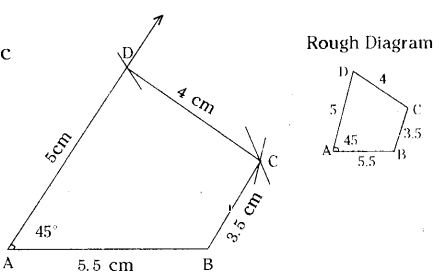
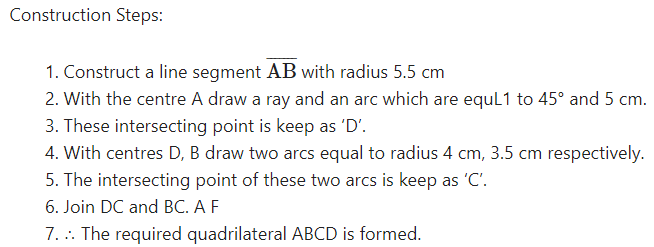
Question (b).
Quadrilateral BEST with BE = 2.9 cm, ES = 3.2 cm, ST = 2.7 cm, BT = 3.4 cm and ∠B=75°.
Solution:
In Quadrilateral BEST
BE = 2.9 cm, ES = 3.2 cm, ST = 2.7 cm, BT = 3.4 cm and ∠B=75°.
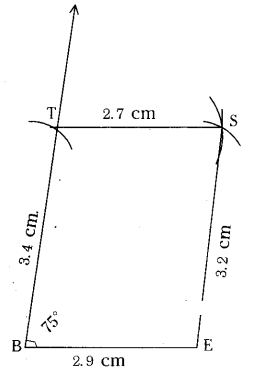
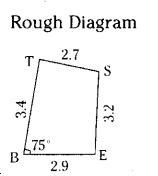
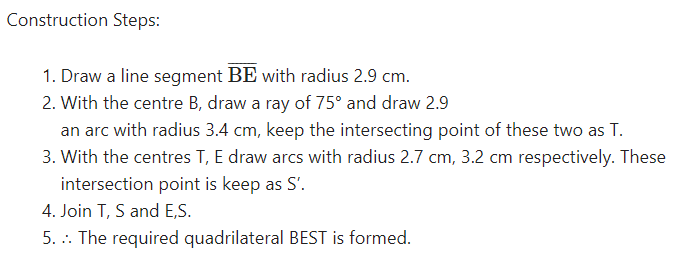
Question (c).
Parallelogram PQRS with PQ = 4.5 cm, QR =3 cm and ∠PQR = 60°.
Solution:
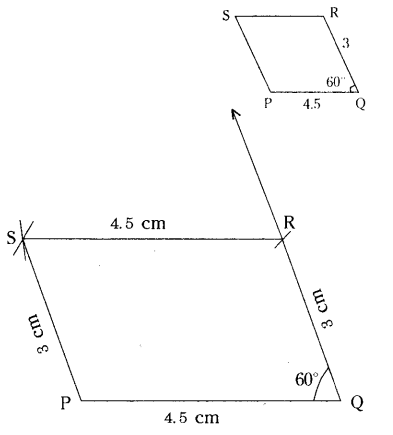
In a parallelogram PQRS
PQ = 4.5 cm, QR = 3 cm, ZPQR = 60°.
=RS4.5cmzPS=3crn
[: Opposite sides of a I)aralielograrn are equal]
Construction Steps:
- Draw a line segment ¡i with radius 4.5 cm.
- With the centre Q draw a ray and an arc equal to 60° and 3 cm.
- The intersecting point of these two keep as R’.
- With the centres R, P draw arcs with 4.5 cm, 3 cm respectively. Keep ‘S’ as the intersecting point of these two arcs.
- Join P, S and R, S.
- ∴ The required parallelogram PQRS is formed.
Question (d).
Rhombus MATH with AT =4 cm, ∠MAT =120°.
Solution:
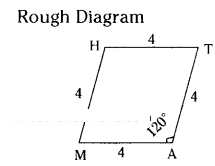
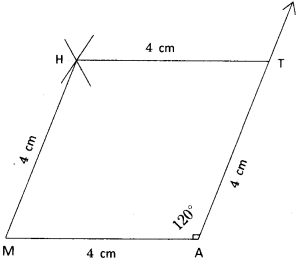
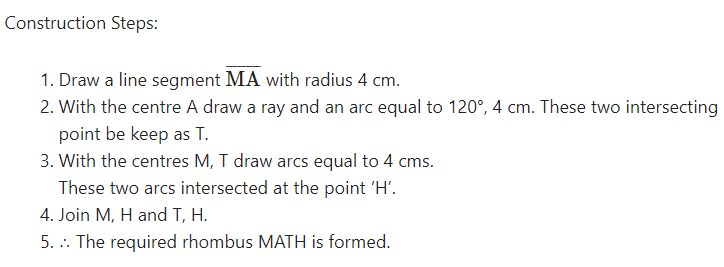
Question (e).
Rectangle FLAT with FL =5 cm, LA= 3 cm.
Solution:
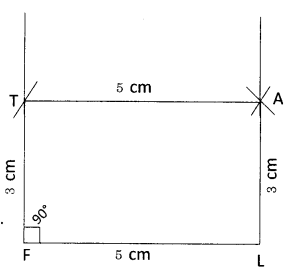
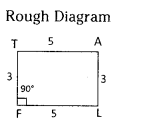
In a rectangle FLAT
FL=AT=5cm, LA = TF = 3cm, ∠F = ∠L = ∠A = ∠T = 90°
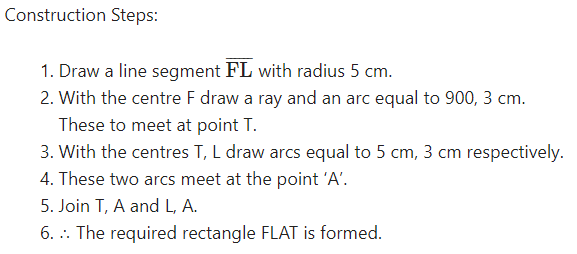
Question (f).
Square LUDO with LU = 4.5 cm.
Solution:
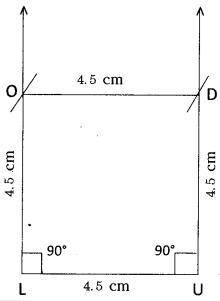
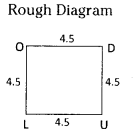
In a square LUDO
LU = UD = DO = OL = 4.5 cm
∠L = ∠U = ∠D = ∠O = 90°
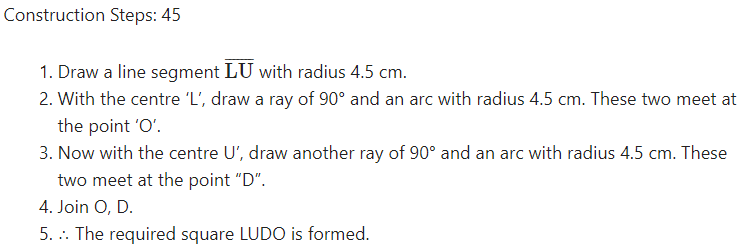
Exercise 3.2
Construct quadrilateral with the measurements given below:
Question (a).
Quadrilateral ABCD with AB = 4.5 cm, BC = 5.5 cm, CD = 4 cm, AD = 6 cm andAC= 7cm
Solution:
In Quadrilateral ABCD with AB = 4.5 cm, BC = 5.5 cm, CD = 4 cm, AD = 6 cm and AC = 7 cm.
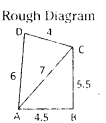

- With the centres A, B draw arcs equal to 7 cm and 5.5 cm respectively. The intersection of these two arcs keep as ‘C’.
- Join A, C and B, C.
- With centres C, A draw arcs equal to 4 cm, 6 cm respectively. These intersecting point is keep as ’D’.
Join D, C and A, D.
- ∴ The required quadrilateral ABCD is formed.
Question (b).
Quadrilateral PQRS with PQ = 3.5 cm, QR = 4 cm, RS = 5 cm, PS = 4.5 cm and QS= 6.5 cm
Solution:
In a quadrilateral PQRS,
PQ = 3.5 cm, QR = 4 cm, RS = 5 cm,
PS - 4.5 cm, QS = 6.5 cm
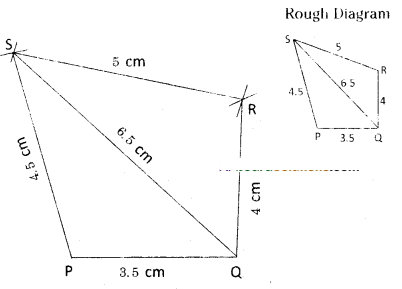

- With the centres P, Q draw arcs equal to 4.5 cm and 6.5 cm respectively.
- These two arcs meet at point ‘S’.
- With the centres S, Q draw arcs with radius 5 cm, 4 cm respectively. These two arcs intersected at point ‘R’.
- Join P, S; Q, S; S, R and Q, R.
- ∴ The required quadrilateral PQRS is formed.
Question (c).
Parallelogram ABCD with AB = 6cm, CD = 4.5 cm and BD = 7.5 cm
Solution:
In a parallelogram ABCD; AB = 6 cm, BC = 4.5 cm, BD = 7.5 cm
AB = CD (;cm
BC = AD = 4.5 cm
BD = 7.5 cm
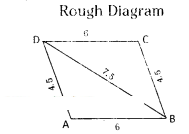
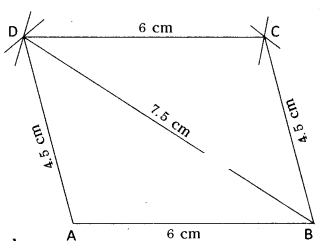

- With the centres A, B draw arcs with radius 4.5 cm, 7.5 cm respectively. These two arcs meet at point ‘D’.
- With the centres D, B draw arcs with radius 6 cm, 4.5 cm respectively. These two arcs meet at point ‘C’.
- Join A, D and B, C and D, C and B, D.
- ∴ The required parallelogram ABCD is formed.
Question (d).
Rhombus NICE with NI = 4 cm and IE = 5.6 cm
Solution:
In a rhombus NI = IC = CE = NE = 4 cm, IE = 5.6 cm
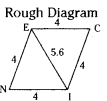
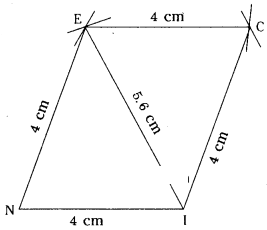

- With the centres N, I draw two arcs with radius 4 cm, 5.6 cm respectively. These two arcs meet at point E’.
- With the centres E, I draw arcs with radius 4 cm. These two arcs meet at point ‘C’.
- Join N, E and I, E. Also join E, C and I, C.
- .’. The required rhombus NICE is formed.
Exercise 3.3
Construct the quadrilateral with the measurements given below :
Question a).
Quadrilateral GOLD: OL = 7.5 cm, GL = 6 cm, LD = 5 cm, DG = 5.5 cm and OD = 10 cm.
(Ex 3.3, Page No. 72)
Solution:
In a quadrilateral GOLD, Rough Diagram
OL = 7.5 cm, GL = 6 cm
LD = 5 cm, DG = 5.5 cm, OD = 10 cm
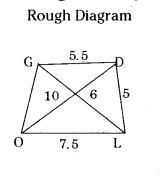
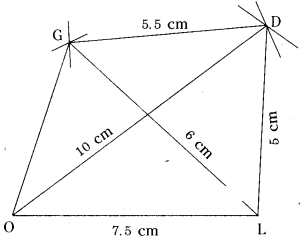

- With the centres O, L draw arcs with radius 10 cm and 5 cm respectively. These two arcs meet at point ‘D’.
- With the centres L, D draw arcs equal to 6 cm and 5.5 cm respectively. These two arcs meet at point ‘G’.
- Join O, G and L, G. Also join O, D and L, D and G, D.
- ∴ The required quadrilateral GOLD is formed.
Question b).
Quadrilateral PQRS: PQ = 4.2 cm, QR = 3 cm, PS = 2.8 cm, PR = 4.5 cm and QS = 5 cm.
Solution:
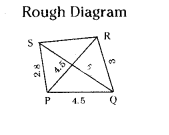
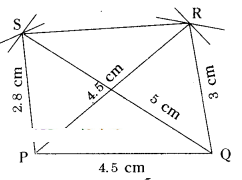
In a quadrilateral PQRS
PQ = 4.2 cm PS = 2.8 cm
QR = 3 cm PR = 4.5 cm
QS = 5 cm

- With the centres P, Q draw arcs equal to the radius 4.5 cm, 3 cm respectively. These two arcs meet at point R’. Join P, R and Q, R.
- With the centres Q, P draw arcs equal to the radii 5 cm and 2.8 cm respectively. These two arcs meet at point ‘S’.
- Join P, S and Q, S and S, R.
- ∴ The required PQRS quadrilateral is formed.